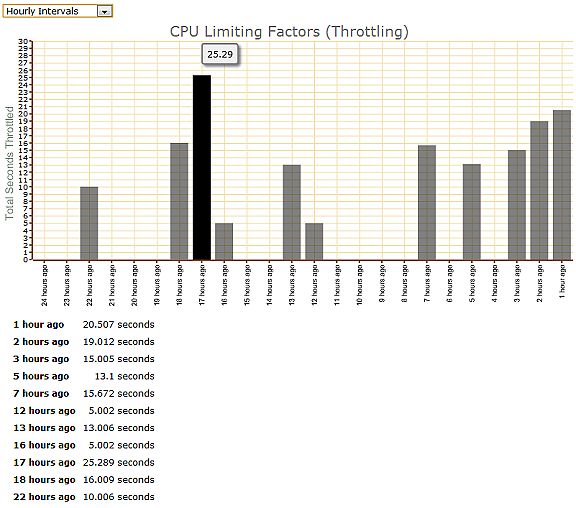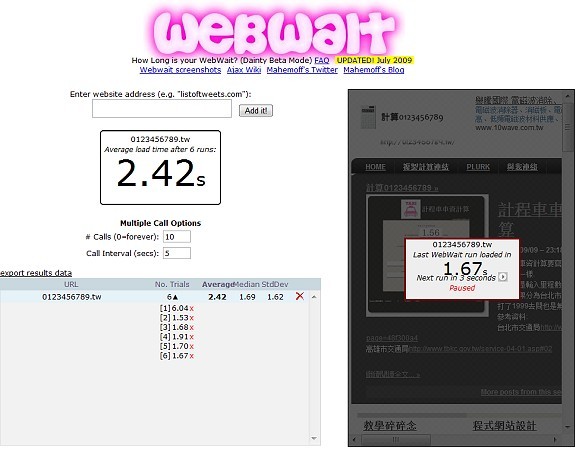
前一陣子換了新主機之後,對於網站的連接載入速度還算滿意,r就這麼使用了半個月之後,突然有一天我連不上本站http://0123456789.tw/,我查看了管理的後臺,才發現可能是因為CPU limit過高?才使伺服器開啟了CPU節流閥(cpu throtting),而使網站被停用了1800秒?就是30分鐘,而這個改變是前一周我的伺服器供應商bluehost有說要更新,之後就多出了CPU throtting這個選項,原本以為是好的功能,確變成時常把我主機關閉的主因,然而納悶的是我的網站也才沒超過10人同時上站為何會這樣呢?不爽中…= =
好了廢話說完,本篇要介紹的是13個可以檢測你的網站速度的網站,傳說人們忍耐網頁載入的極限是7秒,若在七秒內你的網站沒有開啟完畢,大概要進入你的網站的人就掰掰你了,我不常上無名小站因為在他還沒賣給YAHOO之前的那陣子整個龜速到不行,而久而久之就沒習慣上去了,因為真得太龜了,即便是現在,還是有很多人的側邊攔掛了太多有的沒的外掛widget讀取還沒完我就沒耐心等下去了,而人類要養成一個習慣要66天,我養成的習慣是不上無名小站,呵,所以站在使用者立場或者網站SEO優化的立場來說,如果下列網站都將你的網站載入速度測出超過七秒的話,你就要好好思考如何減輕你的網站讀取的東西,例如一些外掛,或者圖片的數量,我再想是因為計算0123456789的首頁有很多縮圖,導致在讀取時會增加CPU的負荷,再觀察看看,若還是這樣可能就要考慮更換佈景主題了,哭哭。

計算網站讀取的資訊網站13個,使用方法都是填入你要測試的網址就OK了
1.
http://webwait.com/
這個網站他會一直讀取你的網頁,所以只有第一次的是比較準確的數值,因為後來的就關係到你本機的快取檔案會加快讀取的速度,



2.
http://tools.pingdom.com/
這個網站測試的蠻詳盡,包括每一個檔案讀出的速度,以及外掛,CSS檔或者script等其他可能是放在他處的檔案,可以看出是誰拖慢速度



3.
http://www.websiteoptimization.com/services/analyze/
這個網站也是詳盡一派的,還列出不同速度的網路會花費多少時間



4.
http://www.iwebtool.com/speed_test
這就很簡單,只有列出幾K幾秒跟平均讀取速度


5.
http://www.selfseo.com/website_speed_test.php
簡單派之二,說穿了網站速度就是列屬於SEO工具的其一


6.
http://www.vertain.com/?sst
這個說是用10MBPS的網路去連接的,下行還列出其他超快速度的網站參考值,不過14.31秒?好像不是很正確



7.
http://www.websitegoodies.com/tools/speed-test.php
這個0.758秒還真鮮,到了小數點下三位,只是我自認沒那麼快,我想是因為讀取太多次硬碟快取檔案加快的原因


8.
http://www.hostpulse.com/hosting/networktools/speedtest.asp
這個其實就是去PING你要測試的網站,你可以開啟MS-DOS自行輸入PING HTTP://XXX.XXX.XXX也可以查看一樣的數值



9.
http://www.linkvendor.com/seo-tools/speedtester.html
這個有分為非HTML跟HTML的部分去測試大小


10.
http://www.webkaka.com/
這是大陸那邊的側是網站,網路卡卡這名稱還真有創意,他可以測試由大陸13個點及國外4個點連入你網站的速度




11.
http://www.aptimize.com/website-speed-test
這個很龜毛,但也算專業,他們是協助你改善速度的公司,註冊後才能使用,他會將測試結果MAIL給你,做成一個PDF的檔案共三頁,我擷圖如下,這個也是第一次讀取要15秒,慘了





12.
http://www.freespeedtest.com/
這個可以測試由世界九個點連入的速度



13.
http://wonderwebware.com/page-speed-tester/
這個是要下載到PC上安裝測試的,測試可以看到他讀取的過程,個人覺得挺公正的,推薦
































